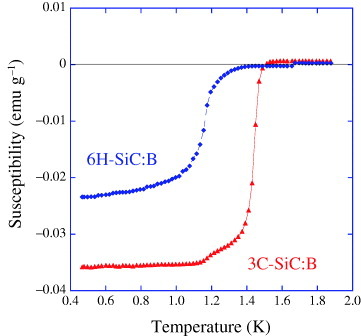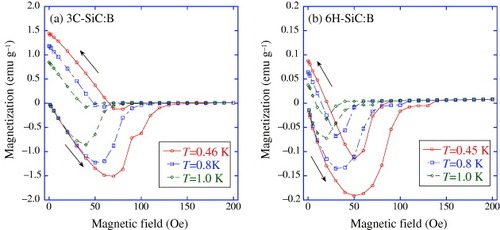Abstract
We report growth and characterization of heavily boron-doped 3C-SiC and 6H-SiC and Al-doped 3C-SiC. Both 3C-SiC:B and 6H-SiC:B reveal type-I superconductivity with a critical temperature Tc=1.5 K. On the other hand, Al-doped 3C-SiC (3C-SiC:Al) shows type-II superconductivity with Tc=1.4 K. Both SiC:Al and SiC:B exhibit zero resistivity and diamagnetic susceptibility below Tc with effective hole-carrier concentration n higher than 1020 cm−3. We interpret the different superconducting behavior in carrier-doped p-type semiconductors SiC:Al, SiC:B, Si:B and C:B in terms of the different ionization energies of their acceptors.
Introduction
The recently discovered superconductivity in B-doped diamond (C:B) by Ekimov et al [Citation1], subsequent enhancement of the critical temperature Tc in thin films to 11 K by Takano et al [Citation2, Citation3], and observation of superconductivity in B-doped Si (Si:B) by Bustarret et al [Citation4] have stimulated renewed interest in the low-carrier-density superconductivity of doped semiconductors. Many experimental and theoretical studies have focused on the origin of the metallic nature responsible for superconductivity in diamond. Investigations continue to clarify whether it originates from the holes at the top of the diamond valence band or from the boron impurity band formed above the valence band [Citation5–15]. In particular, a higher-Tc superconductivity in C:B has been suggested from a theoretical model by a Japanese group [Citation16–18], where bonds transform into bands by carrier doping of a semiconductor. In an extension of research on C:B and Si:B, our group focused on SiC. Silicon carbide has many stable polytypes, including cubic zinc-blende, hexagonal and rhombohedral polytypes. In the cubic zinc-blende structure, labeled as 3C-SiC or β-SiC, Si and C occupy ordered sites in a diamond framework. In hexagonal polytypes nH-SiC and rhombohedral polytypes nR-SiC, generally referred to as α-SiC, nSi-C bilayers consisting of C and Si layers stack in the primitive unit cell. The lattice structures of the 3C-SiC and 6H-SiC phases, which are most important for this paper, are presented in figure .
Figure 1 (a) Unit cell of cubic 3C-SiC. (b) Four unit cells of hexagonal 6H–SiC. For the drawings the software Vesta was used [Citation20].
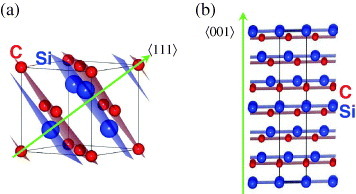
Undoped SiC is a wide-band-gap semiconductor with a band gap of ∼2–3 eV depending on the crystal modification. By carrier doping, we successfully induced type-I superconductivity in boron-doped SiC (SiC:B) with a boron doping level of ∼1.06–1.91×1021 cm−3 [Citation19]. In the previously studied samples [Citation19], both 3C-SiC:B and 6H-SiC:B phases were identified by powder x-ray diffraction (PXRD), and thus it was unclear which phase was superconducting.
SiC opens a new gateway to the physics of the new fascinating family of superconductors originating from wide-gap semiconductors. SiC lightly doped with donors or acceptors was intensively studied for N, P, B, Al, etc, introduced by ion implantation or thermal diffusion. A natural question arises whether SiC exhibits superconductivity when doped by other elements. In semiconductors, an insulator-to-metal transition takes place when the dopant-induced carrier concentration increases a certain level. Moreover, superconductivity has been experimentally achieved in some semiconductors at very low temperatures [Citation21–24] following the theoretical predictions by Gurevich et al [Citation25] and Cohen [Citation26]. Recently, the semiconductor-to-metal transition has been realized in n-type N-doped 4H-SiC with carrier concentration above 1019 cm−3 but without a report of superconductivity [Citation27]; whereas p-type Al-doped 4H-SiC with Al concentration nAl=8.7×1020 cm−3 showed metallic behavior and a small drop around 7 K in the temperature dependence of sheet resistance [Citation28]. The authors mention that this drop may indicate the onset of a superconducting transition.
Here, we report superconductivity of B-doped 3C-SiC and 6H-SiC polytypes and of Al-doped 3C-SiC. Furthermore, we show that the superconductivity in hole-doped semiconductors can be interpreted in terms of the ionization energies of their acceptors.
Experimental details
Samples were prepared by substitutional reaction sintering from submicron 3C-SiC (β form) powder (WAKO, mean particle size 0.27 μm), 6H-SiC (α form) powder (99%, RARE METALLIC), Si powder (99.99%), amorphous boron (99%), and Al powder (99.99%). The powders were mixed in certain proportions (typically SiC/Si/B or SiC/Si/Al with molar ratios 4 : 1 : 0.3–1.0), ground thoroughly, and pressed into pellets. They were then placed in an alumina boat and sintered in a pre-evacuated tube furnace at about 1600 °C for 12 h, with heating and cooling rates of 200 °C per hour, in a flow of Ar/H2 gas mixture (50 ml/50 ml per minute). We have avoided the phase transition from 3C-SiC to 6H-SiC during the sintering, which occurs above 1700 °C [Citation29]. The as-prepared samples were cut into slices and the surface layers were removed before the transport measurements. An electron-probe microanalyzer with a wavelength-dispersive spectrometer (EPMA-WDS, JEOL JXA8200S) was employed for a quantitative elemental analysis. PXRD patterns were collected with CuKα radiation, using a conventional x-ray spectrometer equipped with a graphite monochromator (MultiFlex, RIGAKU), in the range 5°2θ80° at 0.02° step. For dc magnetic susceptibility and magnetization measurements in the temperature range 0.45–1.8 K, we employed a commercial SQUID magnetometer (MPMSR2 Quantum Design Co, Ltd) with a i-Helium3 3He refrigerator. Electrical resistivity was measured with a conventional four-probe technique. The Hall coefficient was measured using a commercial system (PPMS Quantum Design Co, Ltd) in a five-probe ac mode, scanning the magnetic field from −5 to 5 tesla.
Superconductivity in B-doped SiC
The sintered 3C-SiC:B and 6H-SiC:B samples had black ceramic-like appearance. From typical PXRD patterns, the main phases in the 3C-SiC:B and 6H-SiC:B samples are indexed as the cubic zinc-blende 3C-SiC and the hexagonal 6H-SiC phases, respectively. In each sample, unreacted Si is detected. For the major 3C-SiC phase, the refined lattice parameter a increased after sintering, but only by ∼0.1% from 4.3575(3) to 4.3618(4) Å. For the major 6H-SiC phase, the refined lattice parameter c also increased after sintering by ∼0.2% from 15.06 to 15.09 Å. On the other hand, the refined lattice parameter a did not change within the experimental accuracy. Note that the lattice parameter a of commercial 6H-SiC is 3.064 Å. We expect that the presence of liquid silicon facilitates the boron diffusion, due to the much faster mass transport compared to the solid sintering, and enhances the boron substitution efficiency. The lattice parameter of silicon did not change after the sintering, indicating that little boron was doped into silicon.
The atomic sizes of boron and carbon are comparable, but are much smaller than that of silicon. Therefore, the minute change of the lattice parameters suggests that boron substitutes at the carbon site in these samples. We expect the boron substitution to be enhanced with a slow growth of crystal grains, and indeed, by the present synthetic method, the samples had much higher boron doping levels compared to the previous reports [Citation30–33]. EPMA analysis with area-scans (within 50×50 μm2) at various positions occasionally detected less than 0.05 at.% of Fe, together with Si, C and B, but no other elements, in all samples. From Hall measurements at room temperature, the effective hole concentrations n are deduced as ∼1.91×1021 cm−3 for 3C-SiC:B and ∼2.53×1020 cm−3 for 6H-SiC:B.
As shown in figure , the magnetic susceptibility of 3C-SiC:B and 6H-SiC:B in a magnetic field of 1 Oe (zero field cooling process) significantly decreases at ∼1.4 K, suggesting the occurrence of superconductivity. The estimated superconducting volume fraction at 0.45 K exceeds 100% because of the shielding effect. Figure shows magnetization dependences versus magnetic field (M–H) of 3C-SiC:B and 6H-SiC, exhibiting the type-I superconducting behavior. In both compounds, the onset field of magnetization shows a hysteresis with about 30 Oe width at the lowest temperature. From the M–H curves, we estimate the critical field Hc as 100 Oe. The hysteresis width and Hc value are consistent with the previous report on SiC:B [Citation19].
Figure presents the temperature dependence of the electrical resistivity in 3C-SiC:B and 6H-SiC:B. Both samples show metallic conductivity reflecting the high doping level. However, 3C-SiC:B exhibits a much smaller resistivity and almost linear temperature dependence at high temperatures due to the even higher boron doping concentration. The slope dρ/dT is always positive and its temperature dependence is linear for 3C-SiC:B, whereas a broad feature is observed at around 150 K for 6H-SiC:B suggesting a weak carrier localization or a contribution from non-metallic grain boundaries. The residual resistivity ratio RRR (ρ300K/ρ5K) is 11.4 and 4.7 for 3C-SiC:B and 6H-SiC:B, respectively. The inset of figure shows an expanded view of the low-temperature data. Below 1.5 K (3C-SiC:B) and 1.4 K (6H-SiC:B), the resistivity drop indicates a clear superconducting transition and corresponds to the transition temperature observed in the magnetic susceptibility measurements. We note that despite the large difference in the residual resistivity, Tc is nearly the same and the transition width is less than 0.2 K for both samples.
Figure 4 Temperature dependence of resistivity in 3C-SiC:B and 6H-SiC:B. The inset magnifies the region near Tc.
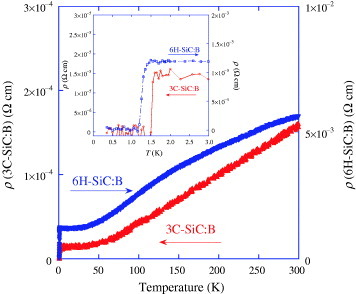
The phase diagram in the magnetic field–temperature (H–T) plane for both samples was determined using resistivity measurements. They involved varying the temperature (heating and cooling) at different magnetic fields (T-scan in figure ), and varying the magnetic fields (increasing and decreasing) at different temperatures (H-scan in figure ). The measurements were performed upon cooling and warming at constant magnetic field (0–80 Oe with a step 20 Oe) as well as upon increasing or decreasing the magnetic field (0–200 Oe) at constant temperature (0.35–1.0 K).
Figure 5 Temperature dependence of resistivity under different magnetic fields (T-scan) in (a) 3C-SiC:B and (b) 6H-SiC:B.
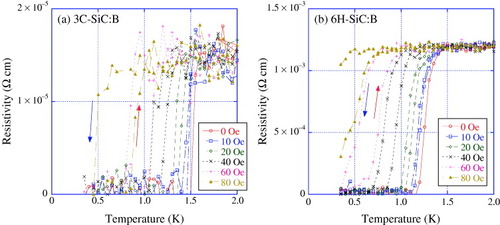
The temperature dependence of the in-field resistivity was measured as follows: the temperature was set above Tc. It was then reduced down to 350 mK (‘field-cooling (FC) run’) and subsequently increased above Tc (‘warming after FC run’). Figure shows the resistivity for H=0, 20, 40, 60 and 80 Oe. In zero field, only one transition is found at Tc, whereas in finite fields, a large supercooling effect is observed in both SiC polytypes. We obtained the same curves independent of the chosen sweep rate, which guarantees that the observed supercooling behavior is an intrinsic property of the sample and that the superconducting transition in both polytypes is of the first order under finite fields. As shown in figure , the hysteresis was also observed in the magnetic field dependence of the resistivity. Above 130 Oe in 3C-SiC:B and above 120 Oe in 6H-SiC:B, we did not find any sign of superconductivity. The observations of the (i) in-field hysteresis, (ii) absence of a hysteresis in a zero field, and (iii) very small value of the critical field give strong evidence for type-I superconductivity in both SiC polytypes.
The H–T phase diagram deduced from the resistivity data is shown in figure . We determined Tc(H) from the onset of superconductivity in T-scan and H-scan both for the field-cooling run (normal-to-superconducting transition) and the subsequent warming run (superconducting-to-normal transition). Applying the conventional formula Hc(T)=Hc(0)[1−(T/Tc(0))α], we obtained a good fitting of the warming data with α∼2.0 for 3C-SiC:B and α∼1.6 for 6H-SiC:B. We identify this transition with the thermodynamic critical field Hc(T); Hc(0)=(132±3) Oe for 3C-SiC:B and (125±5) Oe for 6H-SiC:B, respectively. The same procedure applied to the cooling data yields α∼1.6 in both SiC polytypes. We identify this transition as the upper limit of the intrinsic supercooling limit. The corresponding transition fields are denoted as Hsc (the subscript ‘sc’ stands for supercooling) with an estimated Hsc(0)=(102±6) Oe for 3C-SiC:B and (94±3) Oe for 6H-SiC:B, respectively.
Figure 7 H–T phase diagram for (a) 3C-SiC:B and (b) 6H-SiC:B, determined from the onset of superconductivity in T-scan and H-scan of resistivity.
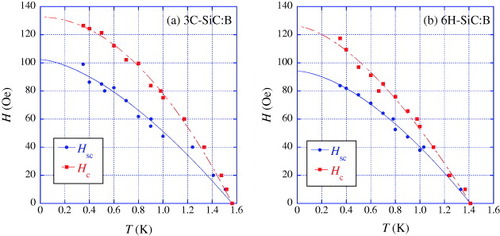
Applying the Ginzburg–Landau (GL) theory of type-I superconductivity to these data, one can estimate an upper limit of the GL parameter κ from the difference of the critical fields obtained by a field-cooling run and a subsequent warming run [Citation34, Citation35]:
. This yields κ∼0.32 for 3C-SiC:B and 0.31 for 6H-SiC:B, in agreement with the analysis of the Hall effect and the specific heat data given above, and therefore supports the type-I nature of superconductivity in SiC:B. Note that the value of κ is below 0.41, which is required in a model based on supercooling instead of superheating [Citation35–37].
Superconductivity in Al-doped SiC
The sintered 3C-SiC:Al sample had black ceramic-like appearance. From a typical PXRD pattern, three phases including 3C-SiC, unreacted Si and Al were identified. The main phase in 3C-SiC:Al sample is indexed as the cubic zinc-blende 3C-SiC. For the main phase 3C-SiC, the refined lattice parameter a increased after sintering by ∼0.1% from 4.338(5) to 4.342(4) Å. Because the atomic sizes of Al and Si are comparable, but are much bigger than the atomic size of C, the minute change of the lattice parameters suggests that Al substitutes Si sites in 3C-SiC. The lattice parameter of Si did not change within the experimental resolution, indicating that little Al was doped into Si. We expect that the presence of liquid Si facilitates the Al diffusion due to the much faster mass transport compared to solid sintering, and enhances the Al-substitution efficiency. This also enhances the C site substitution by Si. EPMA analysis with area-scans (within 50×50 μm2) at various positions detected Si, C and Al and no other elements. From room-temperature Hall measurements, the effective hole concentration was deduced as n∼(3.86–7.06)×1020 cm−3.
As shown in figure , the magnetic susceptibility of SiC:Al in a magnetic field of 1 Oe (zero field cooling process) significantly decreases at 1.4 K, suggesting the occurrence of superconductivity. The estimated superconducting volume fraction at 0.45 K exceeds 100% because of the shielding effect. The inset of figure shows magnetization versus magnetic field (M–H) curves, which are typical for a type-II superconductor. These M–H curves and the value of Tc exclude a possibility that superconductivity is caused by an impurity, such as Al (Tc=1.175 K). From the M–H curves, we estimate the lower critical field Hc1 as 53 Oe.
Figure 8 Temperature dependence of dc magnetic susceptibility in SiC:Al. The inset shows magnetization versus magnetic field at T=0.45 K.

In figure , the resistivity of 3C-SiC:Al in zero magnetic field shows metallic behavior from room temperature, reflecting the high level carrier doping and a sharp drop at 1.5 K and zero resistivity below 1.35 K (inset in figure ). The residual resistivity (ρ0) and the residual resistivity ratio (RRR) are 0.746 mΩ cm and 5.3, respectively. The ρ0 value is higher and the RRR value is lower than those of 3C-SiC:B (60 μΩ cm and 10) [Citation19], but the small transition width (<0.15 K) reveals good quality of superconducting transition in SiC:Al. Among our samples sintered with other nominal compositions, ρ0 and RRR showed minor changes, however, the Tc did not vary. The phase diagram in the magnetic field-temperature (H–T) plane was deduced from resistivity measurements. They involved varying the temperature (heating and cooling) at different magnetic fields (T-scan in figure (a)), and increasing and decreasing the magnetic fields at different temperatures (H-scan in figure (b)). Neither hysteresis nor supercooling behavior were observed in T-scan and H-scan, which is consistent with the transition to superconductivity under magnetic fields being of second order. Thus, a type-II superconductivity occurs in 3C-SiC:Al, in contrast with the type-I superconductivity in 3C-SiC:B. Figure presents the Tc and the upper critical field Hc2, determined from the onset of resistivity, and the irreversibility field Hirr, determined from zero resistivity. Applying the conventional formula Hc2(T)=Hc2(0)[1−(T/Tc)2], we plot the dependences Hc2(T) with Hc2(0)=370±3 Oe and the Hirr(T) with Hirr(0)=140±4 Oe.
Figure 9 Temperature dependence of resistivity in 3C-SiC:Al. The inset magnifies the region near Tc.
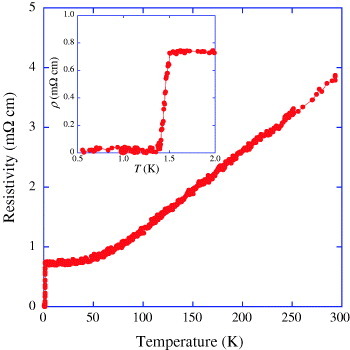
Figure 10 (a) Temperature dependence of resistivity normalized by ρ0 at different applied magnetic fields (0–400 Oe with a 20 Oe step) at 0.35–2 K (T-scan). (b) Magnetic field dependence of resistivity normalized by ρ0 (0.35–1.0 K) at 0–400 Oe (H-scan).
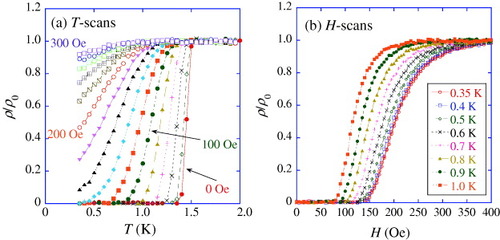
Figure 11 Temperature dependence of the upper critical field Hc2 and of the irreversibility field Hirr in 3C-SiC:Al.
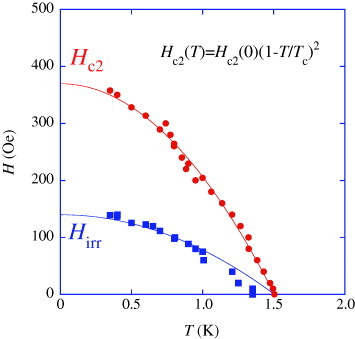
Table 1 lists preliminary specific heat coefficients γn [Citation38]; basic normal-state parameters: Fermi wave number kF, effective mass m∗, Fermi velocity vF, mean free path l; as well as superconducting state parameters: penetration depth λ, coherence length ξ and Ginzburg–Landau parameter κGL. Those parameters were estimated as described in [Citation39]. For comparison, the previously reported parameters for 3C-SiC:B, C:B and Si:B are added. A small but larger than
value of κGL∼1.8 gives an evidence for type-II superconductivity. Our results also imply that 3C-SiC:Al, similar to SiC:B, is a dirty-limit superconductor because ξ(0)≫l.
Parameters of the studied SiC:Al (this work and [Citation38]), SiC:B [Citation39], C:B [Citation1, Citation5] and Si:B [Citation4] samples.
Discussion
Here, we introduce the ionization energies EA of the acceptors for qualitative understanding of superconductivity in doped semiconductors. Theoretically, the superconductivity in doped semiconductors can be interpreted in terms of degree of randomness caused by the impurity band, which is related to EA [Citation17, Citation18, Citation42]. When EA is large (acceptor level is deep), the randomness caused by the impurity band is large. The EA values in p-type semiconductors [Citation40, Citation41, Citation43] are shown in table 2. The EA of 3C-SiC:Al is almost same with that of 3C-SiC:B (type-I superconductor) and smaller than that of C:B (type-II). Type-II superconductivity in C:B reveals carrier localization before the superconducting transition [Citation1–3], and ξ may be reduced by randomness caused by the dopant (80 nm). On the other hand, type-I superconductivity of 3C-SiC:B does not reveal such carrier localization [Citation19], and ξ is not reduced by randomness (ξ∼360 nm). Superconductivity in SiC:Al does not reveal carrier localization, similar to SiC:B, and the κGL value is small (∼1.8), but larger than
. Therefore, from EA value, we consider that the superconductivity in 3C-SiC:Al is at the border between type I and type II.
Ionization energies EA of acceptors in p-type semiconductors, as well as ξ, κGL and the superconductivity (SC) type in doped semiconductors.
In terms of EA, Si:B must reveal type-I superconductivity because EA has the smallest and its randomness due to the dopant must be small, according to theory. In the previous report by Bustarret et al [Citation4], B was introduced to Si thin films using UV laser doping technique. Such B-doped Si thin films may include defects or disorder. Because type-I superconductivity can be hidden and change to type-II behavior by disorder or impurities, type-II superconductivity in Si:B might be influenced by the crystal defects or disorder.
From the same point of view, type-II superconductivity in SiC:Al with a small κGL value may be essentially a type-I superconductivity hidden by crystal defects or impurities. In preliminary ac susceptibility results (T-scan and H-scan), small hysteresis between cooling and warming process was observed (ΔT∼0.02 K at H=100 Oe, ΔH∼19 Oe at T=0.26 K) [Citation38]. Concentration of crystal defects and impurities should be reduced in SiC:Al for a more detailed study of the superconductivity.
Summary
We successfully synthesized boron-doped SiC (3C- and 6H-SiC polytypes) and Al-doped 3C-SiC by a substitutional sintering method and characterized bulk superconductivity in those materials. Both 3C-SiC:B and 6H-SiC:B reveal type-I superconductivity at Tc=1.5 K. On the other hand, Al-doped 3C-SiC (3C-SiC:Al) reveals type-II superconductivity at Tc=1.4 K. Using this observation, the superconductivity in carrier-doped semiconductors can be interpreted in terms of the depth of acceptor levels in p-type semiconductors. One may only speculate on the physical reasons behind this difference. One possibility could be a much different Fermi velocity vF in the case of SiC:B due to a different shape of the Fermi surface. Further experimental and theoretical work is clearly required.
Acknowledgments
We would like to acknowledge Dr M Kriener, Professor Y Maeno (Kyoto University) and Dr Y Yanase (Tokyo University) for helpful discussions. This work was supported by ‘High-Tech Research Center’ Project for Private Universities from the Ministry of Education, Culture, Sports, Science and Technology (MEXT), Grant-in-Aid for Young Scientists (B) (No. 20740202) and a Grand-in-Aid for Scientific Research on Priority Area (no. 16076212) from MEXT.
References
- EkimovE ASidorovV ABauerE DMel'nikN NCurroN JThompsonJ DStishovS M2004Nature428542 http://dx.doi.org/10.1038/nature02449
- TakanoY2006Sci. Technol. Adv. Mater.7S1 http://dx.doi.org/10.1016/j.stam.2006.06.003
- TakanoYTakenouchiTIshiiSUedaSOkutsuTSakaguchiIUmezawaHKawaradaHTachikiM2007Diam. Relat. Mater.16911 http://dx.doi.org/10.1016/j.diamond.2007.01.027
- BustarretEet al2006Nature444465 http://dx.doi.org/10.1038/nature05340
- SidorovV AEkimovE AStishovS MBauerE DThompsonJ T2005Phys. Rev.B 71060502 http://dx.doi.org/10.1103/PhysRevB.71.060502
- YokoyaTNakamuraTMatsushitaTMuroTTakanoYNagaoMTakenouchiTKawaradaHOguchiT2005Nature438647 http://dx.doi.org/10.1038/nature04278
- BaskaranG2008J. Supercond. Novel Magn.2145 http://dx.doi.org/10.1007/s10948-007-0295-7
- BoeriLKortusJAndersonO K2004Phys. Rev. Lett.93237002 http://dx.doi.org/10.1103/PhysRevLett.93.237002
- LeeK WPickettW E2004Phys. Rev. Lett.93237003 http://dx.doi.org/10.1103/PhysRevLett.93.237003
- LeeK WPickettW E2006Phys. Rev.B 73075105 http://dx.doi.org/10.1103/PhysRevB.73.075105
- BlaseXAdessiCConnétableD2004Phys. Rev. Lett.93237004 http://dx.doi.org/10.1103/PhysRevLett.93.237004
- DanWuMaY CWangZ LLuoQGuC ZWangN LLiC YLuX YJinZ C2006Phys. Rev.B 73012501 http://dx.doi.org/10.1103/PhysRevB.73.012501
- NakamuraJKabasawaEYamadaNEinagaYSaitoDIssikiHYugoSPereraR C C2004Phys. Rev.B 70245111 http://dx.doi.org/10.1103/PhysRevB.70.245111
- NakamuraJet al2008J. Phys. Soc. Japan77054711 http://dx.doi.org/10.1143/JPSJ.77.054711
- MukudaHTsuchidaTHaradaAKitaokaYTakenouchiTTakanoYNagaoMSakaguchiIKawaradaH2006Sci. Technol. Adv. Mater.7S37 http://dx.doi.org/10.1016/j.stam.2006.03.010
- FukuyamaH2006J. Supercond. Novel Magn.19201 http://dx.doi.org/10.1007/s10948-006-0157-8
- ShirakawaTHoriuchiSOhtaYFukuyamaH2007J. Phys. Soc. Japan76014711 http://dx.doi.org/10.1143/JPSJ.76.014711
- OhtaYShirakawaTHoriuchiSFukuyamaH2007PhysicaC 460-462121 http://dx.doi.org/10.1016/j.physc.2007.03.265
- RenZ-AKatoJMuranakaTAkimitsuJKrienerMMaenoY2007J. Phys. Soc. Japan76103710 http://dx.doi.org/10.1143/JPSJ.76.103710
- MommaKIzumiF2008J. Appl. Crystallogr.41653 http://dx.doi.org/10.1107/S0021889808012016
- HeinR AGibsonJ WMazelskyRMillerR CHulmJ K1964Phys. Rev. Lett.12320 http://dx.doi.org/10.1103/PhysRevLett.12.320
- SchooleyJ FHoslerW RAmblerEBeckerJ H1965Phys. Rev. Lett.14305 http://dx.doi.org/10.1103/PhysRevLett.14.305
- LasbleyAGrangerRRollandS1973Solid State Commun.131045 http://dx.doi.org/10.1016/0038-1098(73)90529-2
- KangJ HMapsJBerkleyD DJaegerH MGoldmanA M1987Phys. Rev.B 362280 http://dx.doi.org/10.1103/PhysRevB.36.2280
- GurevichV LLarkinA IFirsovYu A1962Sov. Phys.—Solid State4185
- CohenM L1964Rev. Mod. Phys.36240 http://dx.doi.org/10.1103/RevModPhys.36.240
- Da SilvaA FPernotJContrerasSSerneliusB EPerssonCCamasselJ2006Phys. Rev.B 74245201 http://dx.doi.org/10.1103/PhysRevB.74.245201
- AchatzPPernotJMarcenatCKacmarcikJFerroGBustarretE2008Appl. Phys. Lett.92072103 http://dx.doi.org/10.1063/1.2885081
- KrishnaPMarshallR C1971J. Cryst. Growth9319 http://dx.doi.org/10.1016/0022-0248(71)90249-1
- BrachtHStolwijkN ALaubeMPenslG2000Appl. Phys. Lett.773188 http://dx.doi.org/10.1063/1.1325390
- RuraliRGodignonPRebolloJOrdejonPHernandezE2002Appl. Phys. Lett.812989 http://dx.doi.org/10.1063/1.1515369
- GaoYSolovievS ISudarshanT S2003Appl. Phys. Lett.83905 http://dx.doi.org/10.1063/1.1598622
- GaoFWilliam WeberJPosseltMBelkoV2004Phys. Rev.B 69245205 http://dx.doi.org/10.1103/PhysRevB.69.245205
- FinkH JMcLachlanD SRothberg-BibbyB1978Progress in Low Temperature Physics vol VII B D FBrewer AmsterdamNorth-Hollandchapter 6
- YonezawaSMaenoY2005Phys. Rev.B 72180504 http://dx.doi.org/10.1103/PhysRevB.72.180504
- FederJ1967Solid State Commun.5299 http://dx.doi.org/10.1016/0038-1098(67)90277-3
- MarchenkoV IPodolyakE R 2003 Sov. Phys.—JETP 97 154 http://dx.doi.org/10.1134/1.1600807
- KrienerMMuranakaTKatoJRenZ-AAkimitsuJMaenoY 2008 Sci. Technol. Adv. Mater. 9 044205
- KrienerMMaenoYOguchiTRenZ-AKatoJMuranakaTAkimitsuJ2008Phys. Rev.B 78024517 http://dx.doi.org/10.1103/PhysRevB.78.024517
- SamaraG ABarnesC E1987Phys. Rev.B 357575 http://dx.doi.org/10.1103/PhysRevB.35.7575
- Greulich-WeberS1997Phys. Status Solidia 16295 http://dx.doi.org/10.1002/1521-396X(199707)162:1<95::AID-PSSA95>3.0.CO;2-X
- YanaseYYorozuN2008Sci. Technol. Adv. Mater. 9 at press
- FukumotoA1997Phys. Status Solidib 202125 http://dx.doi.org/10.1002/1521-3951(199707)202:1<125::AID-PSSB125>3.0.CO;2-9
